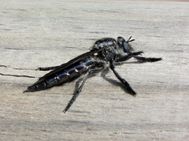A couple of weeks ago, a large insect flew past me at the Urquhart Bluff car park, and landed on one of the bollards.
It looked intimidating, but sat quietly while I took a photo. That night, the words ‘Robber Fly’ popped into my brain, so I looked it up on the internet and discovered it was what I had seen, but I couldn’t find a picture matching my photo, which I sent to the Discovery Centre at Melbourne Museum. As they have no Robber Fly specialists there, they were unable to identify it any further than family Asilidae, and probably genus Laphria.

Asilidae is a species-rich family of predatory flies, commonly known as Robber Flies. They are extremely successful predators, and have voracious appetites. About 340 described species occur in Australia, but the total number of species is much higher. Some 80% are endemic. The adults live mainly in open forest country. They are aggressive predators, feeding particularly on flies, bees and wasps, but attacking almost all insects, including dragonflies; even the hand of the collector is not immune!
When on the hunt, Robber Flies establish a perching location, usually in a sunny open area, in order to locate suitable prey. Once located, Robber Flies catch their prey in mid air, using their strong legs to grasp it; neurotoxins and proteolytic enzymes are injected, and the body juices of the prey are sucked out via the sharp proboscis. Eggs are laid in the soil, are attached to foliage or bark, or laid in seed-heads of grasses. The larvae are cylindrical, elongated, tapered at each end, and have a small, distinct head, and live in soil or rotting wood.
These description are from Sydney University and CSIRO web sites.